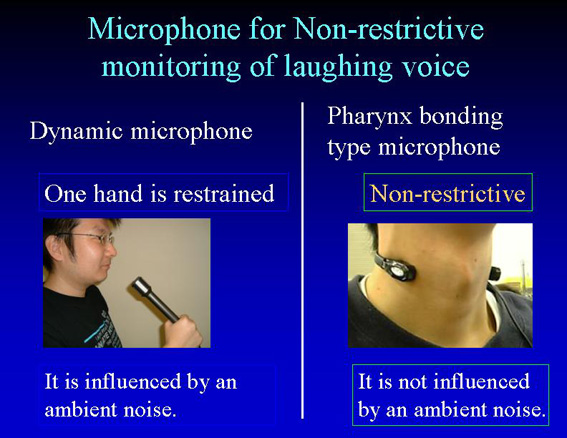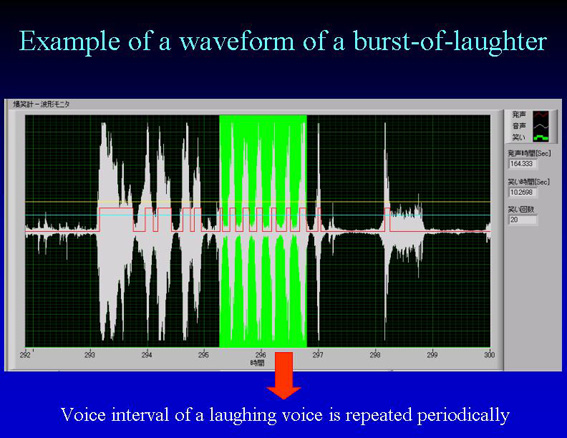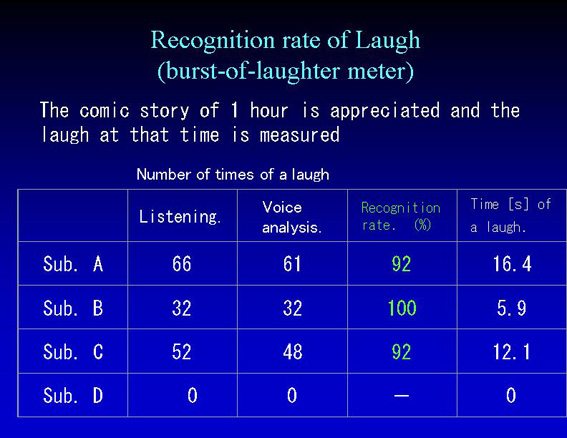Masafumi Matsumura - matumura@amlab.osakac.ac.jp
Faculty of Biomed. Eng., Osaka Electro-Commun. Univ.
1130-70 Kiyotaki, Shijonawate, Osaka 575-0063, Japan
Yutaka Kawabata
Ryoji Suzuki
Masaki Yoshida
Faculty of Biomed. Eng., Osaka Electro-Commun. Univ.
Popular version of paper 1pSC21
Presented Tuesday afternoon, Nov 28, 2006
4th ASA/ASJ Joint Meeting, Honolulu, HI
1. Introduction
A proverb says, "Fortune comes in by a merry gate." From a scientific perspective, laughter is an emotional expression that involves the face and oral cavity. Currently, studies are being conducted to ascertain the relationship between laughter and the promotion of health. It is often said that laughter is the best medicine; humans have long recognized through their personal experiences that laughter is effective for relieving stress and promoting health. In the field of medicine, studies investigating the beneficial effects of laughter on nursing care have demonstrated this point. For example, studies have shown that mirthful laughter while viewing a humorous video activated NK cells, which are an indicator of immune function, stimulated the brain and lowered blood glucose. In those studies that investigate the relationship between laughter and health, it is necessary to gather physiological data and detect the loudness and interval of the laughing voice. In the past, studies have assessed laughter using a questionnaire. However,
few studies have analyzed laughing voices quantitatively. How many times do you burst out laughing in a day? We are attempting to develop a laughter-recognition system that can provide a definitive answer to this question. The purpose of our study is to develop a non-restrictive and long-term monitoring system that measures the frequency and duration of burst-of-laughter instances.
2. Method
For the present study, a
microphone was used to monitor individuals' voices for a long period of time without any physical restraint. This microphone, shown in the right panel in figure 1, detects vocal cord vibrations. It is a "bone-conductive" design that makes direct contact with the individual's body. Therefore, the level of outside noise can be reduced markedly, and the voice can be recorded for a long period of time in a non-restrictive manner.

Figure 1. Monitoring of a laughing voice using a bone-conductive microphone.
For analysis of a laughing voice, concentration on the periodicity (envelope curve) of the voice, e.g. "har har har har," laughter was differentiated from normal conversation based on repeated vocalizations. When a person utters the syllables "har har har har" four times or more at a fixed interval, it is judged as being a burst of laughter, as in Fig. 2.

Figure 2. Example of a waveform of a burst of laughter.
In addition, a field study was conducted to ascertain how much a person talks and laughs in daily life.
3. Results
The present study introduced a non-restrictive and long-term technique for monitoring a laughing voice using a laryngeal microphone. The results can be summarized as follows:
1) A laughter monitoring technique using a laryngeal microphone was introduced; the results showed that the loudness of the actual voice is estimable based on a laryngeal voice recorded using a microphone.
2) Analysis of the laryngeal voice showed that the mean laugh syllable interval was 57-143 [ms]; the greatest standard deviation was 37 [ms].
3) Based on the mean fluctuation (standard deviation) in syllable intervals, 90% of laugh sounds are differentiable from normal conversation.
4) While listening to a live rakugo (Japanese narrative comedy) show, a subject's number of laughs was monitored; the differentiation rate for laughter was 90%, as shown in Fig. 3.

Figure 3. Recognition rate of burst-of-laughter.
5) The present monitoring technique was used to collect data for 10.5 consecutive hours in the life of a student in a non-restrictive manner.
The present non-restrictive, long-term monitoring technique (laughometer) is useful not only for assessing communication behaviors: it might also for reduce the need for nursing care and health promotion. We hope to promote research on the laughometer as an indicator of a subject's feelings in collaboration with medical institutions and the health promotion industry.